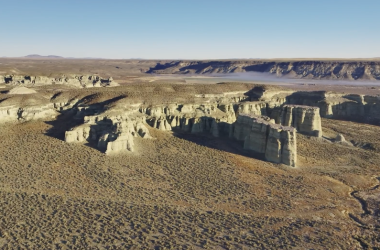
Erik Hartley said he is looking forward to seeing the airport grow in the future. (Liliana Frankel/The Enterprise).
ONTARIO – When Erik Hartley came from South Carolina to consider a job as Ontario’s new airport manager, he “just fell in love with the town.”
According to Hartley, most people who rise to become airport managers at general aviation airports – that’s the category of airport that Ontario Municipal Airport falls into – would probably see the role as a stepping stone toward eventually serving at a big commercial airport that has regular passenger service.
Not him.
“I’m seeking to be hired to retire,” Hartley told the committee that considered his application.
Hartley is from Illiopolis, a small town outside Springfield, Illinois, that he says reminds him of Ontario. He served in the U.S. Air Force and with the Federal Aviation Administration as an aviation safety assistant. While he has been an airport planner before, this will be his first stint as airport manager, replacing Dan Beaubien, who retired.
Now that he’s landed here, he foresees a long future growing alongside the airport, which has been in operation since 1947.
“A lot of airports would just kill to have the decision makers on board to expand the airport and to grow it, the financial capability to expand and grow the airport, and the land to expand and grow the airport,” Hartley said. “That’s the trifecta. And one of my jobs is to be the biggest cheerleader in the local and regional and national communities, and say ‘Come on to Ontario!’”
Hartley emphasized that although the airport’s success or failure might seem separate from the fortunes of Ontario’s everyday citizens, it actually has a large socioeconomic footprint.
At Ontario Municipal Airport, for example, there is educational programming through Treasure Valley Community College. There’s a fixed-based operator – or FBO – run by Frazier Aviation, which Hartley said should be imagined as “the world’s greatest truck stop,” a place where pilots can rest up and planes can refuel and undergo maintenance.
There are private jets that local business leaders and ranch owners use for executive travel. There are helicopters that local ranches use for aerial surveys of their livestock. And there’s activity by the U.S. Bureau of Land Management, which uses the airport in its firefighting operations in the summer.
“There’s a lot of things growing, a lot of things changing, in the Treasure Valley, and this airport is just in the thick of it,” Hartley said.
Although Hartley didn’t have exact numbers on hand for how many aircraft pass through the Ontario airport on a weekly basis, he said that about 60 aircraft are based there, and that the airport has about as many jet aircraft as Nampa and Caldwell have combined.
Hartley said that citizens who are concerned that the city is investing too much into the airport should know that “the numbers that are going back to the city from the airport outweigh that.”
He said that revenue from sources like the fuel tax and the hangar rent represented significant income for the city.
The airport, he said, “should be a huge source of pride for where this part of the country’s going.”
News tip? Contact reporter Liliana Frankel at [email protected] or 267-981-5577.
YOU CAN SUPPORT THIS KIND OF WORK
The Enterprise relies on community support to fund vital local journalism. You can help us do more.
SUBSCRIBE: A monthly digital subscription is $5 a month.
GIFT: Give someone you know a subscription.
ONE-TIME PAYMENT: Contribute, knowing your support goes towards more local journalism you can trust.




